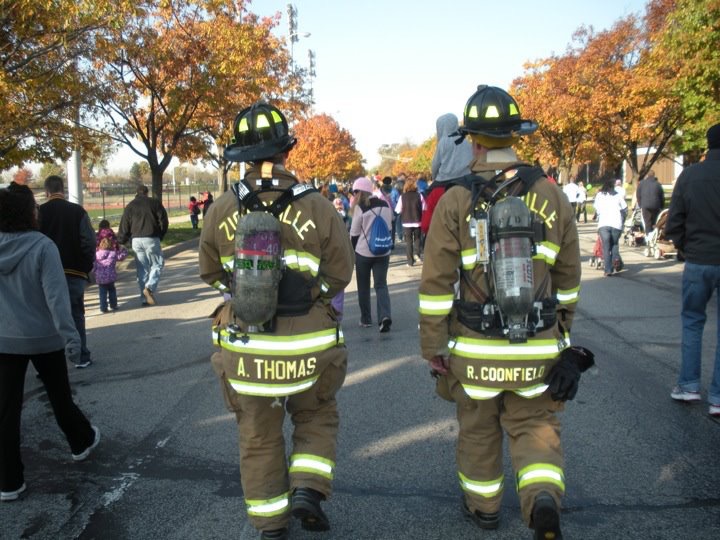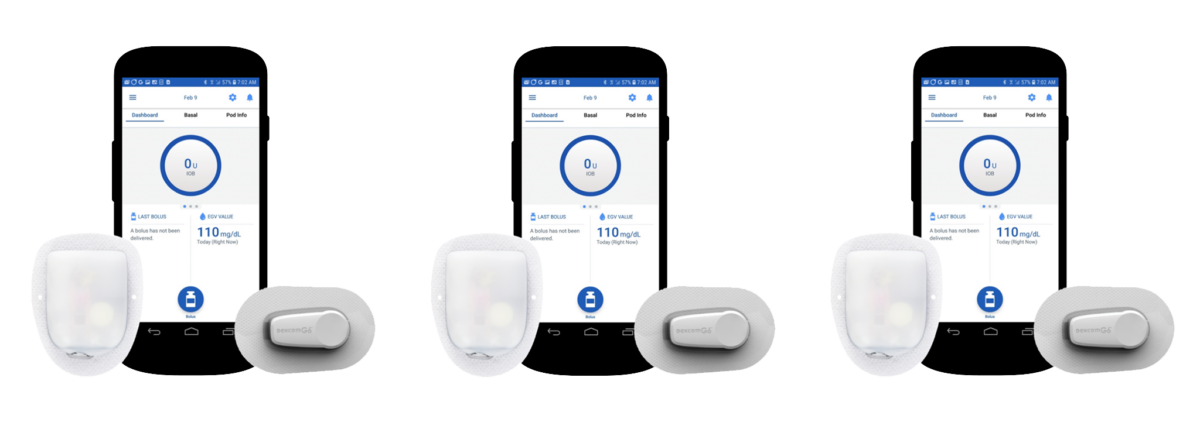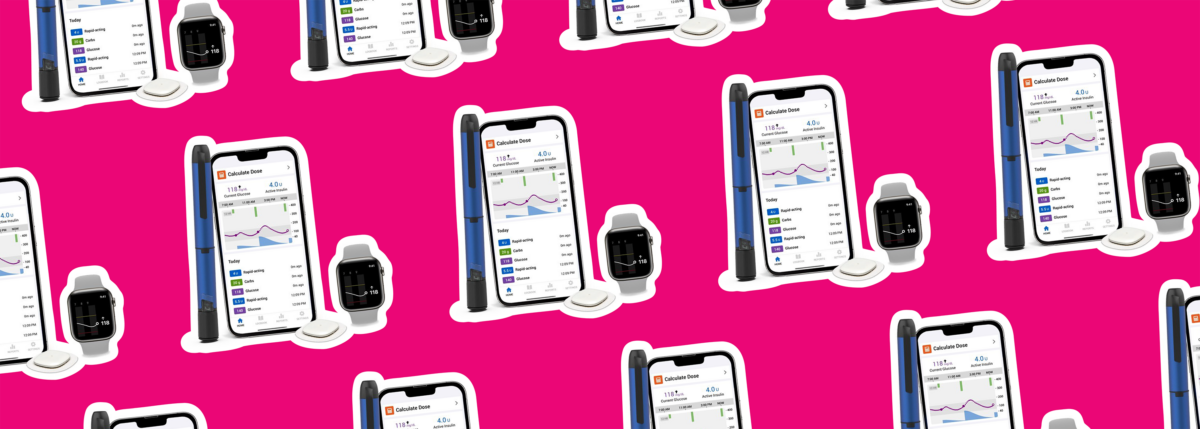Fighting Fires with Type 1
Written by: Katie Doyle
6 minute read
May 30, 2017
Andrew Thomas answers all of our burning questions (pun intended) about life as a firefighter with type 1! He’s had type 1 diabetes for over 23 years and he’s been with his fire company in Indiana for nearly 10.
“It would have been great, in my eyes, if I were a kid and had somebody be like, ‘Yeah, you can do that!'” Andrew says.
But it’s definitely not easy, he explains. “I say to myself, ‘Okay, you got the job. You became a firefighter. Be the best one. Don’t let THIS prevent you from being the best one.'”

BT1: When did you decide you wanted to be a firefighter?
AT: I have a lot of members of my family that are in the military. I wanted to grow up to be in the military, to follow in those footsteps. I found out at a young age, 13, 14 maybe, that because of diabetes I would not be allowed to be in the military, at all, period. So that’s pretty crushing.
As a little kid, I remember conversations with my mom where I said, ‘I want to be in the military,’ or ‘I want to be a firefighter,’ or ‘I want to be a police officer.’ Those were the kinds of things that I wanted to do. So when I found out that I couldn’t be in the military, I just assumed that included being a police officer and a fireman. But I had this itch in the back of my head that this is the type of thing I’m supposed to do, and I had people saying, ‘You’re not allowed,’ or ‘You can’t.’ That was rough.
[After high school] I met this fire chief who told me it might be possible—so that glimmer of hope was all it took for me to just get after it.
BT1: Can you tell me about the process for becoming a firefighter? Did you have to do anything differently compared to your colleagues?
AT: The process is very standard across the board: there’s a written exam, there’s an interview, there’s a physical agility test called CPAT (certified physical aptitude test). To pass CPAT, you have to walk on a stair machine with a 75-pound weight vest for three minutes. And then they take it down to 50 pounds while you go through a series of obstacles. That series of obstacles could be carrying a chainsaw 50 feet down and back, hitting a rubber machine that simulates hitting a door, and then you have to carry a hose and stretch it so far and then crawl back. Some departments time you; for others, it’s pass/fail.
But the biggest fear for me was the very last thing: the health physical. After a psychological evaluation, you do a health physical—and that’s where pre-existing conditions come up.
All the firefighters pay into a pension fund. You have to be examined and labeled as ‘healthy enough’ to pay into this for a minimum of twenty years. If, at any point, a pre-existing condition causes someone to not be able to be a firefighter anymore, it could potentially cause them to not receive their pension. That’s called an exclusion. So that becomes, for me, added motivation and fuel to the fire to be fit and healthy and not have to think about that. In my department of 75 guys, I’m probably in the top 10 healthiest guys in the department.
BT1: What about when you’re out on the job?
AT: Every fireman has their pile of gear that they take on the truck with them: it’s their fire gear, helmet, mask.
I have a cooler full of Gatorade, gummies, energy tubes and granola bars. And before I had a sensor, I had a glucometer that was always in the cooler.
BT1: I’ve always wondered: how important is it that I wear a medical ID bracelet? Do EMTs, firefighters and other medical personnel know what an insulin pump is?
AT: Any time we come upon someone who’s unconscious, or is not acting right, we always check their blood sugar. Always. If nobody can tell us why, we’ve got to figure out why. You have to go through this process of elimination, and blood sugar is always there.
I’ve never, in my career as a fireman, identified someone as being diabetic because they were wearing an ID bracelet. Usually their friend or family member says, ‘Oh, they’re diabetic.’
One time a UPS guy found a man slumped over at his desk, unconscious. He tried to revive him and he couldn’t, so he called 911. We showed up, and there were no physical signs that this guy was diabetic. He didn’t have a bracelet on, he didn’t have an insulin pump, there was no test kit sitting on his desk. We checked his blood sugar and his blood sugar was like 1.6 mmol/L28 (mg/dL).
We gave him D-50—D-50 is just sugar straight into your vein. It wakes people up in, like, seconds—and an IV and he woke up two minutes later. We were like, ‘Hi, are you diabetic?’ and he was like, ‘Yep!’ [He laughs.]
 BT1: How do you manage your diabetes? What technology do you use?
BT1: How do you manage your diabetes? What technology do you use?
AT: [I was on multiple daily injections] from the age of 9 to 17. I was always really resistant to change. At 17, my endocrinologist finally convinced me to try out an insulin pump.
Now I use the Omnipod and the Dexcom sensor. The tubeless design really appealed to me. One day, I was at the firehouse, sitting in a recliner, eating and relaxing on our chill time, and the pump had fallen out of my gym shorts and gotten wedged in the recliner. The tones dropped for a run, and I jumped up to run and when I did, the pump site got ripped out because the pump was stuck in the recliner.
BT1: So when all of a sudden there was a call and your pump ripped out, is that something you would just deal with later? Or can you super-humanly change your site while you’re getting dressed to fight a fire?
AT: I would just deal with it later. At that time, I knew my blood sugar was good. If it became an extended scene, if I was going to be out there for a long period of time, I’d find my battalion chief and I’d be like, ‘This is what’s going on, we need to get this taken care of.’ They would get me out of there, back to the firehouse, I’d get my site changed. We very much take care of each other [in the fire service].
BT1: What’s your favorite part of being a firefighter?
AT: Part of it is that I’m still a little kid, and I love big trucks, and my job is to drive that big truck. I also get to break stuff for a living. I’ve broken into people’s homes and they thank me for it because they locked themselves out. I get paid to work out. I get paid to cook for the guys. We talk to kids, and kids think it’s so cool to be a fireman. Across the board, I love it.
BT1: Do you tell the people you respond to for diabetes emergencies that you have diabetes?
AT: Sometimes I do, sometimes I don’t.
We had a guy whose blood sugar was 2.2 mmol/L40 mg/dL. He was conscious, he was just out-of-his-head confused. We sat him down, we made him eat, but he kept messing with his insulin pump. He was just repeatedly giving himself insulin. I took his insulin pump off of him.
It was an Animas pump, I had used one before, and [it turns out that] he was trying to prime the pump. I ended up getting it primed and got his basal rates set up and all squared away. It was a situation where the guys there wouldn’t have known what to do. The guys will ask me all the time: ‘If I’m trying to help somebody, and they’re on an insulin pump, how do I turn it off?’ And I’m like, ‘Don’t ever touch their insulin pump. I don’t care if their blood sugar is 20, don’t touch their insulin pump. You do not need to take off somebody’s insulin pump or turn it off because you could cause them a bigger problem.’
BT1: Do you have to follow any regulations when it comes to managing your blood sugar at work? Or are you left to manage it as you normally would?
AT: They kind of let me do my thing because they see me as being fully capable of taking care of myself. I know that when I first got hired, they were kind of like ‘Holy crap, how are we going to deal with this?’ But they quickly realized, ‘This guy’s got his stuff together. We have nothing to worry about.’
Being transparent about that was very important to me. I mean, I live with these guys every third day. They know more about each other than they do about their spouse, so we’re very close, we’re very tight. When I got hired, I was possessed with this drive to show everyone, ‘You don’t have to worry about this, ever.’ That’s why I worked so hard to be the best—to be in shape, to be the most trained, to almost obsessively prove to everyone, and myself, that I could do this job better than anyone without diabetes.
My specific job for the last year has been to drive the fire truck. So the fact that these guys will suit up and jump in the back seat with a person with type 1 diabetes driving them and they have zero worry about that, that’s a big compliment to me.
BT1: Do you ever have days where you wish that you didn’t have to work as hard to prove that you’re excellent at your job?
AT: Honestly, my mentality to be the best at something I’m passionate about goes far beyond diabetes. I feel honestly that I would be the exact same person without it. I probably would have went into the military, that would be the only difference, but I would have pushed really hard to be the best I could have in the military. That’s who I am.
Sometimes I do wish I could sit and eat when everybody else does—by the time I check my blood sugar and dose up my pump, and this and that, everybody’s halfway done!
BT1: You thrive under pressure! How do you deal with that constant feeling of responsibility? Do you have any advice for how other people with type 1 can deal with it, too?
AT: My favorite part about being a fireman is when someone calls 911, they do not get to choose who arrives to help them. How can you not be the absolute best option for that person?
The community I serve deserves the best effort and care, not excuses or someone who says, ‘I can’t.’ For me, it was just another added piece of motivation to do this job successfully despite my condition. People are always watching. If I fail and blame diabetes, then I’m proving I don’t belong here and others like me don’t belong. If I screw up and give everyone with diabetes a bad name, then maybe someone else won’t get the opportunity that I got because a fire department could look at me as a bad example.
My goal is to be the best despite my condition, to the point where it’s not even part of the equation. Most people I meet don’t know I have diabetes, and most people that I know very well almost forget that I have diabetes, and that’s on purpose.
Read Jordan Morris and His Professional Soccer Career with Type 1 Diabetes.

Author
Katie Doyle
Katie Doyle is a writer and videographer who chronicles her travels and diabetes (mis)adventures from wherever she happens to be, and she’s active in the community as an IDF Young Leader in Diabetes. She’s written about dropping her meter off of a chairlift in the Alps, wearing her pump while teaching swim lessons on Cape Cod and the many road trips and fishing expeditions in between—she’s up for anything and will tell you the story about it later. Check out www.kadoyle.com for more.
Related Resources

Already compatible with Dexcom’s G6 and G7 continuous glucose monitors (CGMs), the Omnipod 5 Automated...
Read more

The younger a person is diagnosed with type 2 diabetes, especially those with obesity, the...
Read more

The Oura Ring, which tracks things like sleep, heart rate, and activity, is joining forces...
Read more

